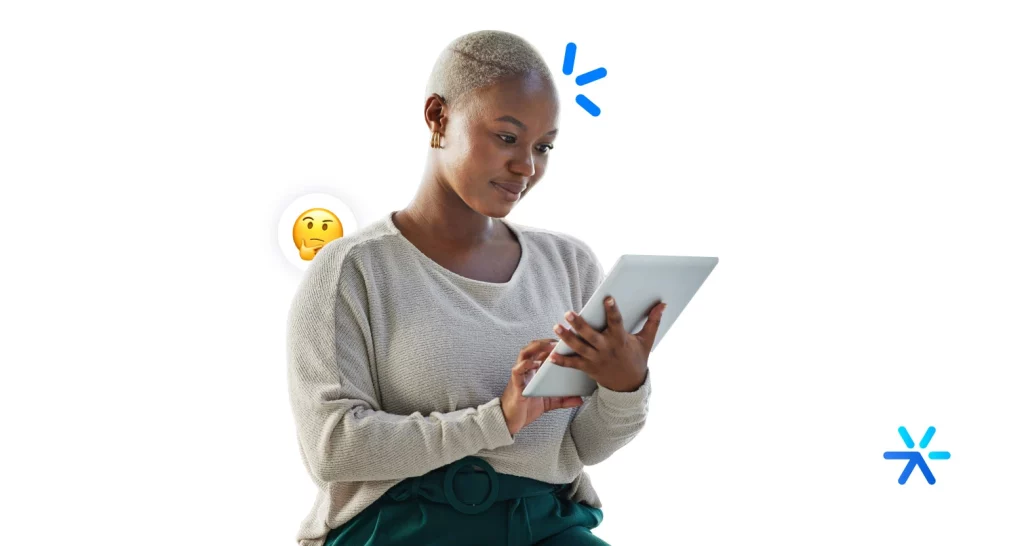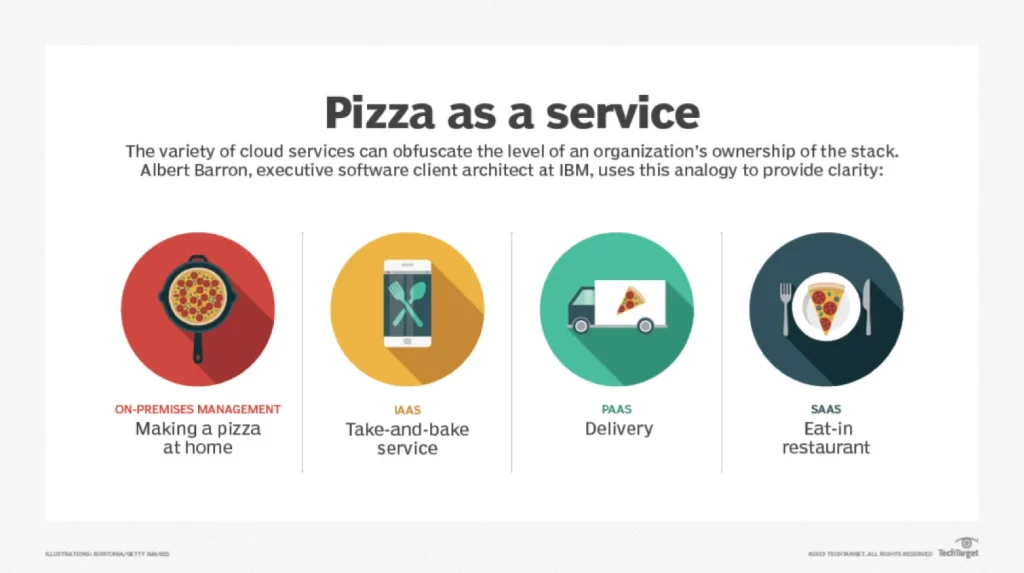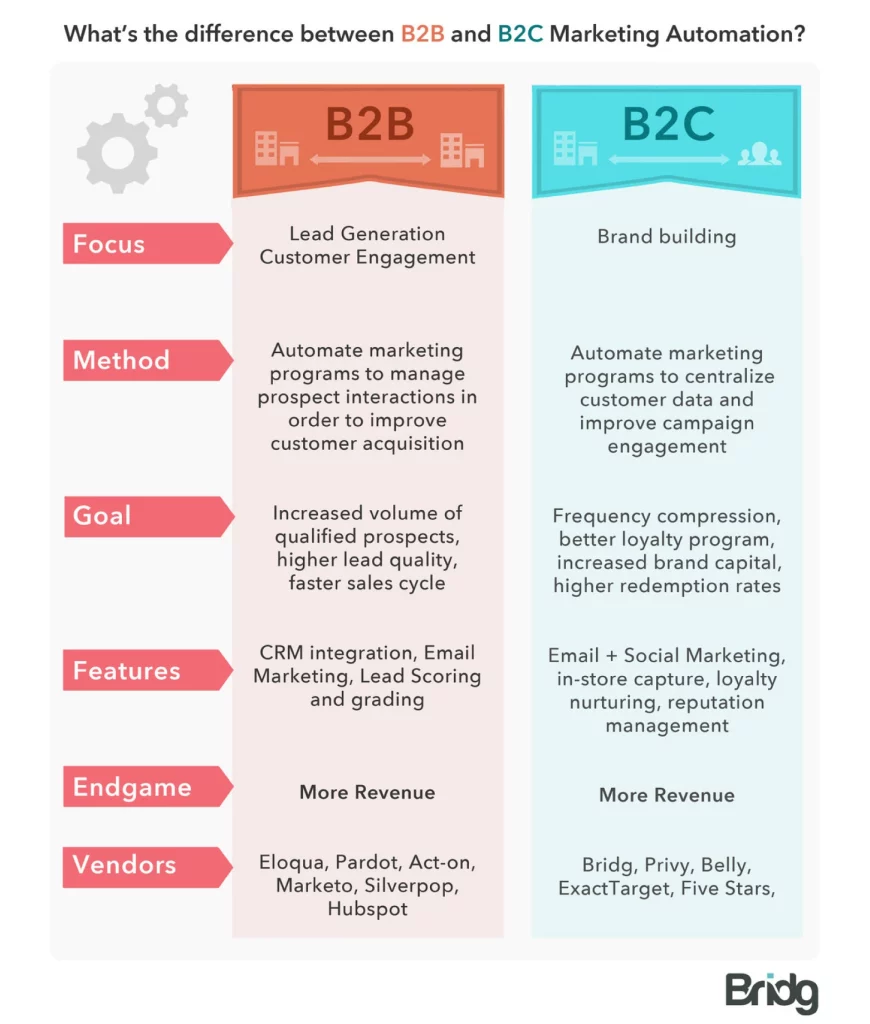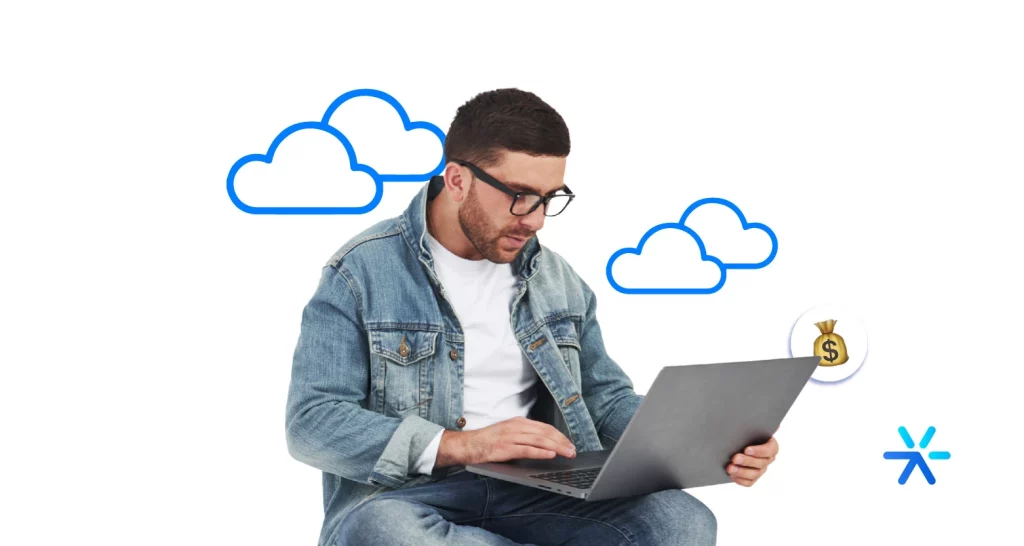B2B SaaS Marketing How To: Where to Start and Finish
Working business-to-business is a constant challenge. B2B SaaS Marketing can be even more complex because it adds the software segment into the equation.
There are important steps you need to strategize in SaaS Marketing. We have several articles on the topic here on the blog, which I will show you throughout the article. But in this one, we will talk more specifically about B2B.
The complexity I’m referring to is not about bringing more people to your site, converting them into leads, or guiding these leads through your Marketing Funnel.
What is complex in B2B SaaS Marketing is the preparation of your strategy. It needs to be tailored to your business model, your clients’ business models, and your own market.
This is our topic today. We will work through all these points throughout the article. Shall we proceed?
How does B2B SaaS work?

SaaS, or software as a service, is the name we give to software that is sold online and implemented through the cloud.
In other words, your client does not have a physical copy of the software installed on their computer. They access the service through a website or platform.
However, it is important to analyze your business model to understand if it truly is SaaS. Many companies are mischaracterized in the model.
So many that Albert Barron, a software development executive at IBM, uses the following scheme to better explain the differences:

According to this analogy, B2B SaaS is a shared experience between the provider and the client, using the provider’s technology, without the possibility of altering the functionalities of this technology by the client.
This is an important point to highlight because SaaS is often confused with PaaS — Platform as a Service — especially in the B2B environment.
For example, Salesforce works with PaaS, not SaaS, because its solution is a platform where you can build custom apps for your work routine.
At the same time, Leadster is SaaS, not PaaS, because it delivers the app ready to use.
This is a very simplified version of the differences between the two models, but the important thing here is to understand exactly how B2B SaaS works, and consequently, B2B SaaS Marketing.
Shall we delve deeper into the topics below?
Differences with B2C SaaS
B2B means Business to Business, or company to company. While B2C means Business to Consumer, or from company to the general consumer market.
This is the most basic point in the differences between the two: one serves other companies, the other serves the general consumer market.
B2C SaaS has some very clear differences compared to B2B SaaS. The first of these is a strong focus on Product Led Growth in its purest and least diluted form.
B2B SaaS companies can also work well with Product Led Growth. But to close higher deals and expand the customer base, other methodologies need to be worked on together — such as Account Based Marketing.
B2B SaaS Marketing frequently uses more contemporary Inbound Marketing techniques, highlighting Content Marketing. B2C SaaS also uses them, but not with the same intensity.
The fact is that the SaaS sales process is more complex and requires many more concurrent strategies in practice. And in these strategies, a higher volume of material production.
B2B must, out of necessity, manage its lead generation process and closely monitor it to achieve sales success.
In B2C, the focus is on brand awareness, positioning, Outbound Marketing, influencer marketing, and more traditional advertising means.

PLG X MLG X SLG
There are three main models of Growth Marketing: Product Led Growth, Marketing Led Growth, and Sales Led Growth.
Each of these methodologies seeks to drive the growth of the B2B SaaS company in a different way.
In PLG, the focus is on the product, its development, and the monitoring of its usage. In B2C, this strategy can work very well on its own.
In MLG, the main focus is on Marketing, especially Digital Marketing. Inbound, Content, and Outbound work together for healthy lead generation, with approaches generally made by email.
In some cases by phone, to close the sale. Others via WhatsApp, others through online meetings, etc. The important thing is interaction.
In SLG, the responsibility lies with the sales team. Cold calling, client visits, personalized quotes, and the constant search for new potential clients within the ICP are some of their main concerns.
It’s important to mention these three models because B2B SaaS Marketing transitions a bit through all of them. Companies in this sector are different, so it’s quite uncommon to find one that adopts a single strategy and that’s it.
Typically, B2B SaaS companies work in a mixed model, PLG and MLG, with some light touches of SLG incorporated as well. Throughout the article, we will discuss this further.
The most important KPIs for B2B SaaS
KPIs are Key Performance Indicators. All companies need to create their own KPIs in conjunction with their OKRs, as this is a fundamental part of their growth.
KPIs are metrics with an extra dimension of interpretation. For example: “number of views on the site” is a metric, but “annual growth of unique visitors” is a KPI.
The most important KPIs for B2B SaaS Marketing are the following:
- Recurring Revenue: you can analyze this KPI annually (ARR) or monthly (MRR). It is important because it indicates the predictability of your revenue according to your contracts and/or subscriptions;
- Lead Generation: the KPI measures the number of leads you are generating in any channel — organic or paid, inbound or outbound;
- Lead Qualification: a very important KPI that measures the number of people successfully passing through your Digital Marketing Funnel;
- Cost to Service — how much do you spend to provide your service to a client? Include website and software hosting costs, support costs, onboarding meetings, etc.;
- Customer Acquisition Cost — how much do you spend to generate a new client? Mainly include your Marketing expenses;
- Lifetime Value — how much revenue does each client generate for you during their lifecycle;
These are some of the main ones, and the most important to start tracking if you are still taking your first steps in B2B SaaS Marketing.
If you want to go further, I have a great article listing 20 more KPIs and discussing each of them in detail. Just click the link below 😉
🤿 Dive deeper: The 20 SaaS Metrics that Companies in the Sector Track
How to start doing B2B SaaS Marketing

As we have discussed so far, each B2B SaaS company will have its own operating model, related both to its product and business model, and to what the competition is doing.
The thing is, this personalization in Marketing always comes with some common tactics and strategies. These strategies can be applied in different ways and with different results in mind, but they don’t change much.
Another point: if you are just starting to work with B2B SaaS, putting a good strategy into action is always your first step.
With time and the necessary observations, you will better understand how to make the process more customized and more in line with what your clients expect.
So, shall we discuss the basics a little more? And in the next topic, we will see some examples together to understand how personalization can work.
Come with me:

How to Identify the Target Audience
At this first step, you will likely notice some important points about how to make your B2B SaaS Marketing more personalized.
The reason is simple: you will get to know your potential customers as deeply as possible. How do they consume media? At what time? What type of media? How do they decide on a product for the company? Who is involved in that decision?
These are fundamental points for knowing your target audience in the B2B sector. Such questions need to be answered, and in many cases, they are difficult to obtain.
The best thing you can do for now without spending much is to start by making a list of companies that would use your services with the help of LinkedIn.
Then look up the employees of those companies, read their profiles, see what they interact with and what they say. Twitter can also be very valuable in this regard, as it concentrates very specific profiles from various segments, all related to work.
The topic is very extensive, and it’s impossible to tell you everything you need to do in a single subtitle, so I won’t even try. But I have some material that will help you a lot; just click on the banner below 😉
How to Increase Lead Generation
Lead generation in the software sector starts with a simple premise: you need to drive people to your site, offer conversion opportunities, and use the best tools to make it happen.
But there are some important points to consider in this work.
Most SaaS companies work with a mix of organic and paid traffic to generate leads. Organic traffic represents the content path: blogs, social media, and YouTube, primarily.
The objective is simple: through keyword research, find out what the most urgent issues are for your prospects and address them through content production. This article you are reading is an example of that.
Paid media, or Performance Marketing, works a little differently. You will look for the same keywords in the case of the search network, but instead of creating content, you will create ads.
The consensus is that Paid Media works faster in lead generation, but it increases the Customer Acquisition Cost, and once you stop investing, the results stop coming in.
At the same time, organic traffic delivers leads more aligned with your ICP and with more qualification opportunities, but in the long term: if you start today, you will start seeing the first results in three to six months.
How to Convert Leads on the Site
A very important point that almost no other article on the internet mentions is the actual conversion of leads on your site — how does it happen? By what means?
I’m talking here about the actual conversion, the way it happens. Your visitor comes to your site, is reading your content or looking at your products. Where are the opportunities for you to convert them as a lead?
Most B2B SaaS companies today work with Landing Pages with long forms and low conversion rates. These landing pages work very well at the Top of the Funnel, but not so much at the Bottom of the Funnel.
Just think: you run an ad to capture more Bottom of the Funnel leads. Where do your visitors go? To the contact page, without the products? To the product page, but without the contact?
The best tool today for lead conversion at any stage in the Funnel is a Chatbot. Through it, you can impact anyone at any stage of the journey on any page of your site.
Simply because it integrates perfectly with all these pages. A chatbot like Leadster also offers you the ability to create flows according to the origin of the leads — whether it was Google Ads, another platform, SEO, etc.
The Leadster Chatbot is more intuitive than a Landing Page and much simpler to implement.
It also offers a Dashboard for easy monitoring of the number of leads being generated in your different flows, which are 100% customizable.
You can do a quick test without difficulty now. Just click on the banner below:
How to: Demand Generation
Demand Generation is a Growth strategy focused on creating demand for your product or service. From the name, this is quite obvious. But in practice, what are the first steps?
The work of generating demand is complex and operates at all stages of your Marketing Funnel and also in all stages of the Consumer Journey.
Basically, the work consists of producing content at scale, according to the main pain points of your target audience, focusing on expanding your market or building it. This content is distributed across various areas and platforms: blog, YouTube, social media, etc.
A great example of Demand Generation is the work done by giants like HubSpot: they invented a new Marketing methodology — Inbound — while launching a Marketing CRM and courses to certify more people.
DemandGen is about influencing the market. Resultados Digitais did something very similar: through its courses, blog, agency partnership programs, and a lot of investment, it brought the HubSpot Marketing model to Brazil.
The difference between Demand Generation and Content Marketing is not in the form but in the strategy. DemandGen seeks to expand the business horizons through content and copywriting.
Meanwhile, Content Marketing seeks to position you as an authority on an already established point in the market, driving your lead generation in that direction.
In other words: these are distinct strategies but complement each other. Content Marketing is one of the main resources of Demand Generation, but it is by no means the entire strategy nor the only tool.
How to Nurture Leads
Almost all the efforts we mentioned so far will arrive at the same destination: the segmentation, qualification, and nurturing of leads.
So far, we have mainly discussed how to generate leads, which is the part that requires more resources and time. But what about afterward, once they are generated?
That’s where lead nurturing comes in. The vast majority of the leads you generate will be at the Top of the Funnel or the Middle of the Funnel, and they need a process to reach the Sales Funnel and close with you.
This process is lead nurturing. It is mostly done via email Marketing and through automation with a Marketing platform, in addition to Remarketing campaigns in paid media.
This platform will organize your leads and allow you to create nurturing automations, with rules you determine. For example: one day after downloading a Lead Magnet, receive email X. Two days later, email Y with other material. Three days later, another email, etc.
You will follow this flow until you determine that your lead has become an MQL. At this point, they move to the Sales Funnel to be qualified by the sales team.
How to Close Sales
The final step for your B2B SaaS sales engine is to set up a Sales Funnel.
The Sales Funnel begins at the last stage of the Marketing Funnel, after the lead has transformed into an MQL. The process should be worked until the MQL becomes an SQL — Sales Qualified Lead.
Here is where the common points start to differ. It’s very difficult to show you how the process should be done because each company will have specific needs, especially in B2B!
What you need to know is that your leads need to be qualified by the sales team with information such as Fit, purchase availability, available budget, etc.
It is also necessary to map the company’s structure as much as possible, understanding who the influencers in the purchase process are, who the decision-makers are, the best times for meetings, etc.
See how this last process is quite hybrid, mixing Marketing Led Growth with Product Led Growth and a bit of Sales Led as well.
For a less diluted experience, many SaaS companies work with Product Led Growth in various different plans. In Self-Service, leads can become customers on their own, with the help of content, tutorials, etc.
In the Transactional model, the customer acquisition process is more guided, with meetings to present the product, etc.
And in the Enterprise model, hiring can only be done through the sales team, with discussions about features, prices, etc., directly with the salespeople.
5 Examples of Successful B2B SaaS Marketing

All good so far? You have noticed throughout the article that B2B SaaS Marketing is quite personalized and involves many different variables.
Therefore, to understand how it is applied in the market today, the best thing is to follow brands that work in the same segment as you. Analyze their practices, business model, how they work their marketing, and follow the customer journey.
Many companies even hire the services of their competitors in the various plans they offer just to see how the process is.
Now let’s analyze some B2B SaaS companies to better understand and put into practice everything we’ve discussed so far. Come with me:
HubSpot
HubSpot handles Demand Generation so well that it practically invented a market within digital marketing.
They created a content team focused on SEO and Demand Generation, a Lead Magnets team, and a battalion of Inside Sales to immediately call all qualified leads.
Looking at the site, several strategies we’ve discussed here are quite evident. Check it out:

Right on the first fold, you see very important points. First: the focus on the demo.
This focus is crucial because the Demo is an essential point in B2B SaaS Marketing. Leads that test the product go straight to the Bottom of the Funnel, reaching almost instant qualification.
Another point to highlight is the button next to the demo: start using it for free. It’s part of HubSpot’s PLG, a Self-Service offer so the lead can work their process on their own.
And there in the corner, we see the Chatbot button, encouraging the visitor’s independence and minimizing contact with people (which increases CAC), but without losing that personalized touch.
All this in a single screenshot. And if you click on the top menu, you will see the vast amount of content the company makes available in their Demand Generation and leadgen:

HubSpot represents the most popular strategy in B2B SaaS Marketing: expanding the market and being democratic for all types of customers, from the smallest to the largest.
But this tactic is not shared by all B2B SaaS companies in the market. Let’s look at a different example:
Adobe Marketo
Marketo is a robust Marketing automation platform, mainly aimed at advanced users.
Precisely for this reason, its approach to B2B SaaS Marketing is quite different from HubSpot’s. The biggest difference, which you’ll see below, is the absence of Self-Service plans. See:

You can watch a tour of the tool. You can understand how it works. But the site does not show any pricing information, only what each plan does. To know the prices, you need to talk directly to a sales representative.
In fact, even to get a demo, you need to take this extra step. Why opt for this MLG model instead of offering the demo for free and a Self-Service plan?
We would need to ask Adobe’s head of Marketing 😅 But broadly speaking, it is common for such strategies to be seen in more comprehensive products, with many features and a lot of added value.
SEMRush
There are cases of B2B SaaS companies that go far beyond PLG. So much so that many customers use the free plan for months and even years before seeing the need to subscribe.
That’s the case with SEMRush. The platform offers fewer features in the free plan, but what it offers is enough for the main pain points of its target audience: competitor research and simplified organic traffic report generation.

This is the free SEMRush Dashboard. It offers traffic volume, lists of well-performing keywords, visit variations, among other more detailed information.
As you use the product more and more, emails will keep arriving in your inbox, offering more features and even a free upgrade for a limited time.
I’ve even been approached by Inside Sales representatives by email, and it was a real person. They asked about the company size, the purpose of the software in it, among other important points.
This is another case where the barriers of B2B SaaS Marketing are quite fluid. Several approaches are possible. The important thing is what your lead needs.
Leadster
We follow a similar approach to HubSpot. We are quite Product Led and understand that the best way for our lead to understand how to use Leadster is by using it themselves.
But we also offer the three classic plans: Self-Service, Transactional, and Enterprise, because B2B has these complexities. Some people want to test, take it to management, which takes it to the board, which evaluates the possibility.
Other people are the directors themselves and want to see the software running with the least time wasted. Everything is relative, but the lead’s desire is Law.
This is the first fold of our site. Notice how the focus is mainly on getting people to take the Demo. This is a fundamental part of our strategy.
Another important point is our work in demand generation. You won’t find many companies with our focus: Chatbot for lead generation.
You’ll see many Chatbots for WhatsApp, for site support, etc. But lead generation is our market, which we are building little by little and with your help 🤓
To finish, one last word: now it’s your turn to study us in practice.
Visit the site, take a test, learn about our plans and our tool. Read our blog, watch our videos on YouTube, feel free to study our business model.
After all, we are also B2B SaaS 😉 And we are learning from the market, like everyone else.
Take the test today. It’s free and doesn’t require a credit card. Open the notepad and start taking notes. And when you need a Chatbot to generate more leads on your site, you know who has it, right?
Thanks for reading. See you in the next article.








